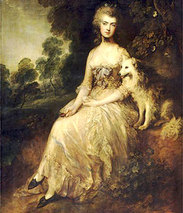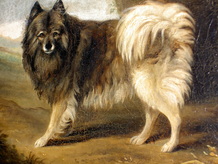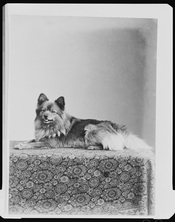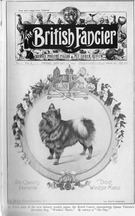The Early History
|
All photos enlarge on clicking
The Vikings have been blamed for a lot of things – rape, pillage, bloodshed, and worse. Even the Normans who conquered Britain in 1066 at the Battle of Hastings had been Vikings just 150 years before, coming to an agreement with France that they could have the area that became Normandy if they left the rest of France alone. They had many major achievements militarily and on the sea. But their most significant achievement to a small band of dog-lovers worldwide was to be the means of introducing a small furry dog with a curly tail and a foxy face to a watery area somewhat south of their homeland of Scandinavia. It is rumoured that some thousand years ago a Viking ship foundered off the coast of Friesland. All the crew were drowned, apart from one man who was saved by a local fisherman in his cog (the style of boat used by the Friesian fishermen) with his dog. The two men and the little white dog tried to reach the coast in the fisherman’s boat but were caught in a storm and forced southwards, until eventually they managed to land on a small area of higher ground. There they built a small chapel to give thanks for their deliverance, and this is where Amsterdam slowly grew to be an important town. The Great Seal of Amsterdam (see pictures) records this event, and you can just see the little dog peering over the side of the boat. |
|
There are sightings of spitz throughout the next seven hundred years, with examples being seen in an illuminated manuscript from the fourteenth century which is held at the British Museum, and a depiction on items of pottery from Greece from the fifth century (see picture to left). The name spitz did not come into use until the fifteenth century. When the name did come into use it became an insult, and in about 1450 Count Eberhard zu Zayne, a gentleman living on the Rhine, issued an order to his retainers forbidding them to use the term! Before that they were known as “mistabella” on the farms, where they were used as watchdogs.
|
|
It is during the eighteenth century that the instances of the spitz seem to increase, probably due to the adoption of the breed as a mascot by the Dutch Patriot Party (see picture left) which was led by Cornelis de Gijselaar, Kees for short. The little dog who followed him everywhere was known as Kees. In Holland its popularity was as short-lived as the popularity of the Patriot Party, but in Britain it seemed to become something of a fashion accessory with several artists using the dog in their work. Gainsborough has depicted the spitz several times, as in the well-known “Perdita” (top right) and in the picture shown here of the wedding of Mr. and Mrs. William Hallet, (below right) where the dog knows nothing of the solemn occasion and is trotting expectantly by his mistress’s side, probably waiting for something nice to eat! Gainsborough also painted a Pomeranian with her puppy. (top far right) Another example of the spitz in art was an engraving (bottom far right) of a boy’s “Return from School”, by London engraver W. R. Bigg in 1790, where the boy is being greeted enthusiastically by his dog – obviously he has as much trouble with two-legged greetings from his dog as I do.
|
|
The Prince of Wales, later King George IV, had a keeshond which was depicted in this wonderful painting, (left) thought to be by Thomas Gooch 1750 - 1802. The prince gave the picture to the first Marchioness Conyngham, who was his last mistress. She lived at Slane Castle, Co. Meath in Ireland, where the painting is still owned by the descendants of the Marchioness.
|
|
"Overweight Pomeranians", as the British Keeshond was called in the 19th and early 20th century, weighed generally about 16 - 20 pounds, so they were rather smaller than most of todays Keeshonds. They lost popularity in the early years of the 20th century, and Challenge Certificates were withdrawn by the Kennel Club in 1915. Queen Victoria, who bred Pomeranians during the 1880's, was known to have had an "overweight pomeranian" which featured on the front cover of the "British Fancier" in 1892. (see Windsor Marco, right)
|
|
Ch. Tilton Sable (right) was bred by Mrs. Morton (by Victorias Marquis of Anglesey - unregistered x Victorias Susindia - unregistered) and owned by Mrs. Liversidge.
1910 - wins at Birmingham and Westminster Pet Dog Show 1911 - CC at Cruft's under Mr Bowler 1912 - numerous wins from Edinburgh to Cruft's CC at Earls Court under Mr Norris 1913 - CC in June at Taunton under Miss Lee Roberts He gained his Championship in 1914 at the age of six. |
|
Our Keeshonds today, whether in the US, Australia, Europe or Britain, can be traced back to a very few dogs from Germany and Holland at the turn of the 20th Century. Dogs such as Texel (whose father was a samoyed, and whose mother was called Mina), and Schie, Dirk, Edam and Fips Sauter formed the basis for the modern Keeshond.
Left is Kees van Scheveningen, owned in the late 19th century by Heer Kuyl van Gijn of Scheveningen. Also left is Lux, who was born in 1893 and became an international champion. He was owned by Herr Charles Kammerer of Germany. He was described as "full of quality, but light of bone and too long in muzzle" see Alice Gatacre's "The Keeshond" Kees (left) was exhibited by Miss Beverley in 1899. He had been given to Miss Beverley by friends in Nijmegen, as a special favour, as the Dutch were said to be very jealous of these dogs.The dog caused a stir because he was shown as a "Keeshond" in a class for foreign varieties, i.e. breeds not recognised by the Kennel Club. A member of the Dutch Embassy wrote to the secretary of the LKA saying that the Keeshond is the national dog of Holland. This claim was dismissed by an eminent authority on foreign dogs, Mr. H. C. Brooke, who claimed the dog was "merely a specimen of the common large Wolfspitz" and that if there had been a national dog of Holland it would have been heard of before. taken from Mr G.M. Hicks book, "The Pomeranian" |
|
Meanwhile the keeshond was being noticed elsewhere. Gwendolen Hamilton Fletcher, at the age of 17, went sailing with her parents and friends in 1902 in their new yacht “Joyeuse” to Holland. As they approached the shores and began meeting the sailing barges everyone was excited to see the little dogs on board the barges. The dogs ran up and down the length of the barges yapping to see this great yacht approaching. There was conjecture among the party on the yacht as to what these dogs could be. Were they mongrels? No, they could not be as they were all alike. They looked like miniature alsatians (German Shepherd Dogs). They spent so long wondering about these dogs that they did not make their destination that night, and decided to moor at the village of Zaandam. (see painting, right, by Monet, who lived in Zaandam for a while) They stayed there a week, noticing these attractive little dogs wherever they went. And that is really the beginning of the keeshond story in Britain and America.
|
|
|
Two puppies were bought for two guilders each and they were brought up on the yacht. They were named Barkles and Zaandam. (see picture left) Two years later another two puppies were bought, and named Dirk and Edam (see picture) who became the basis of the Van Zaandam line. They produced Amalia van Zaandam, who was mated with Terschelling, son of Schie (daughter of Dirk and Edam) and Texel, a Dutch dog with a Samoyed for a father. Amalia and Terschelling produced Saanie and Breda, (see picture on the next page - 1920's - taken at the Birmingham National Show in 1923, the first show at which the Dutch Barge Dog had been shown).
Once the First World War was over and Mrs Wingfield Digby, as she now was, was able to devote her time to the breed together with her husband, Major Wingfield Digby, they researched together the history of the breed with the help of books, articles and Dutch friends. They came to realise that they had an ancient breed of dog and began the task of getting it recognised as such by the UK Kennel Club. |


















